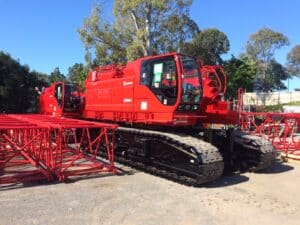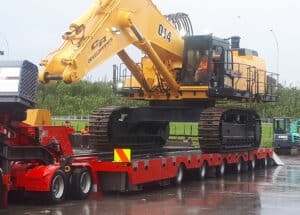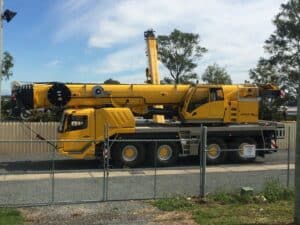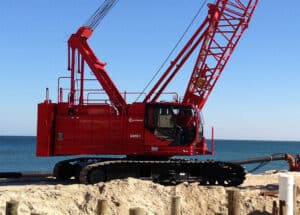Understanding Crane Parts And Their Fascinating Roles

Cranes are a type of industrial machinery used in various industries such as mining, construction, manufacturing, and transportation. Many people don’t recognize all the intricate parts and pieces that make up a crane and the vital role they play in ensuring the operation goes smoothly. This article will dive into the inner workings of these machines, exploring the different parts of a crane and their specific functions.
Basic Parts of a Crane
The Boom
The main boom is what sets a crane apart from other types of heavy machinery. Different boom models include telescoping, extendable and hydraulic, each providing different levels of reach and height. It is the boom which holds the wire rope cable and hook block, and it can be swung to move from area to area. This feature allows for the manoeuvring of heavy objects in areas with limited space since it can bypass many barriers. Some cranes need to be assembled for use, like a tower crane, while others, such as the hydraulic truck crane boom, have telescopic sections for enhanced range.
Counterweights
Counterweights are an essential part of cranes that are designed to lift and manoeuvre very heavy loads. They are used to balance the load so the crane can lift the load and keep it steadily in place. Counterweights play a very important role in several types of cranes such as jib, platform, and truss cranes.
A counterweight is a mass attached to the crane hook that opposes the weight lifted. It helps the crane to maintain a steady, balanced position while lifting the load. The counterweight’s weight is typically around 20 to 30 per cent of the load that is being lifted so the crane can remain within its design parameters.
Counterweights improve the crane’s overall safety and help to reduce stress on its components by providing load stability. They also reduce the overall time it takes to construct and dismantle the crane, as no extra manpower is needed to balance the crane while hoisting the load. Furthermore, counterweights provide enhanced safety for the operator as the crane is more stable when making the lift.
In addition to providing load stability, counterweights are crucial in allowing the crane to move and transport its load. Without counterweights, the crane’s components would be under constant strain as the crane would have to continually adjust for the varying weight of the load. Counterweights help to prevent the crane’s parts from becoming overstressed and, consequently, reduce the risk of unexpected breakage and accidents.
The most common types of counterweights are fixed and removable counterweights. Fixed counterweights are bolted to the crane and provide a fixed weight. These counterweights are usually based on manufacturer and crane model specifications and are typically chosen to match the required lifting capacity of the machine. Removable counterweights are designed to be attached to the crane hook and removed as the crane lifts and manoeuvres the load.
Operators Cab
The Operators Cab is a critical component of modern crane systems, providing a comfortable and safe environment for crane operators while they’re manoeuvring the crane’s load. The cab needs to be properly maintained and the operator needs to be well trained on its use in order to ensure that the crane and its load are moving safely and efficiently.
The Operators Cab is typically located at the rear of the crane’s cab and is the primary workstation for the crane operator. It typically contains a variety of controls and indicators, such as a throttle, hoist and boom controls, speed indicators, and warning lights. The cab also holds the operator’s chair, which must be properly adjusted in order to ensure the safe and comfortable operation of the crane.
In order to ensure the safety of the crane’s operator, the cab must be fitted with appropriate safety features. The cab should have a sturdy floor, guardrails, a windscreen, and fallen object protection to safeguard the operator in the event of an accident or malfunction. Additionally, the cab should be fitted with fire extinguishers, an emergency stop switch, and other safety equipment.
In addition to providing a safe environment for the operator, the cab also plays an important role in the long-term reliability of the crane’s operation. As the cab is where the operator’s vision is focused, any obstructions or defects can negatively affect its placement and capability. Proper maintenance of the cab is essential for reducing operator fatigue and ensuring that the crane can be safely operated over long periods of time.
Auxiliary components of a crane
Outrigger pads
Outrigger pads provide a stable platform for equipment operators to set up and use their cranes on a construction site. Outrigger pads provide much-needed support and stability when mobilizing heavy equipment on otherwise unstable surfaces. Without them, operating mobile cranes would be difficult and dangerous.
So, what are outrigger pads and how do they work? Outrigger pads are heavy steel plates usually made from steel, cast iron, or aluminium. They’re typically weighted to ensure an even distribution of the crane’s weight, as placing the pads near the edges of the crane increases the risk of tipping or tipping over. The feet area is typically made of flat, corrosion-resistant material like rubber or plastic to stabilize the crane on wet surfaces, such as mud, gravel, and asphalt.
Once the outrigger pads are put into place, the outriggers extend in order to even out the crane’s weight. This ensures that the crane is stable and secure. To ensure maximum safety, outriggers must all be parallel and level before the crane can be fully deployed. If not, the crane could tip over, causing catastrophic damage and potential injury.
Outrigger pads ensure that the crane can safely move heavy loads, and they prevent the crane from collapsing due to uneven weight distribution. Not only do they boost stability, but they also help to minimize the risks of crane accidents. By creating a secure base, outrigger pads effectively eliminate the risk of tipping, toppling, and sliding.
Jib
The jib expands the length of the main boom, staying fixed and going farther outward than the main boom. This gives the telescopic crane a greater reach, allowing it to manoeuvre around obstacles or reach spots where crane placement is difficult perpendicular to the target.
Luffer
A luffer, or luffing crane, differs from a jib crane in that it has a hinge rather than being fixed. The hinge gives the luffer the ability to be moved vertically in addition to horizontally, thus increasing the range of motion the crane can reach.
Rigging Equipment
The hardware typically used at the hoisting end of a crane for rigging purposes can include a hook, load block, hook block, wire rope cable, turnbuckles, spreader bars, lifting beams, eyebolts, pulley blocks, and other similar items that provide a lift point for a heavy load or ensure its stability during lifting.
Operating Parts of a Crane
Engine
The engine of a crane is an integral component that enables the crane to lift, lower items, and complete various other functions. In many cases, the engine is a gasoline-powered or diesel-powered engine, although electric-powered engines are also becoming more popular. The engine powers the entire crane system, and the size of the engine required for the job depends on the crane lifting requirements.
The main function of the engine of a crane is to provide power for the hydraulic pump that runs the crane’s functions. The engine supplies the necessary torque to turn the pump in order to generate the pressure needed to power the hydraulic components. The engine is also responsible for supplying power to the crane’s controls, such as its control levers, chains, and brakes. Depending on the type of crane, the engine may also be used to power other crane components, such as the winch and beacon lights.
The engine must be of adequate size and power to provide enough power for all the crane’s functions. The size and power of the engine is determined by the weight of the items being lifted, the speed at which the crane must move, and the frequency of the tasks that the crane must complete. In addition, the engine must be capable of providing enough energy to operate the controls of the crane, such as the levers, chains, and brakes.
One of the most important aspects of the engine of a crane is ensuring that it is properly maintained and lubricated. All necessary lubricants must be changed or refilled regularly such as the different oils, greases, and fluids. In order to ensure maximum efficiency and safety, the engine should be inspected on a regular basis and any necessary repairs should be done promptly.
Controls
The specific capabilities of a crane will determine the kind of controls it requires. The minimum requirement would be hydraulic controls to regulate lift and rotation, but additional features like the ability to raise/lower outriggers, control booms and move jibs/luffers require specialized hydraulic control systems.
Crawler and All-terrain cranes on the other hand need driving controls like brakes, throttle and steering, while larger ones to be used on the roads require additional components like headlights, signal lights, a horn, parking brakes, windshield wipers etc., as per DOT regulations for legal operation on roads.
Certified Operator
A certified crane operator is essential to the safe and successful operation of a crane in your business. Accidents and damage to property can be minimized by having an experienced and skilled operator, who is kept up-to-date with relevant industry safety briefings.
Conclusion
The carefully designed structure of a crane is a marvel of modern engineering. Knowing the different parts and their roles will help you understand the science and skill behind its structure. With many preventive measures in place, a crane is an invaluable asset with its many applications in a wide range of fields.







